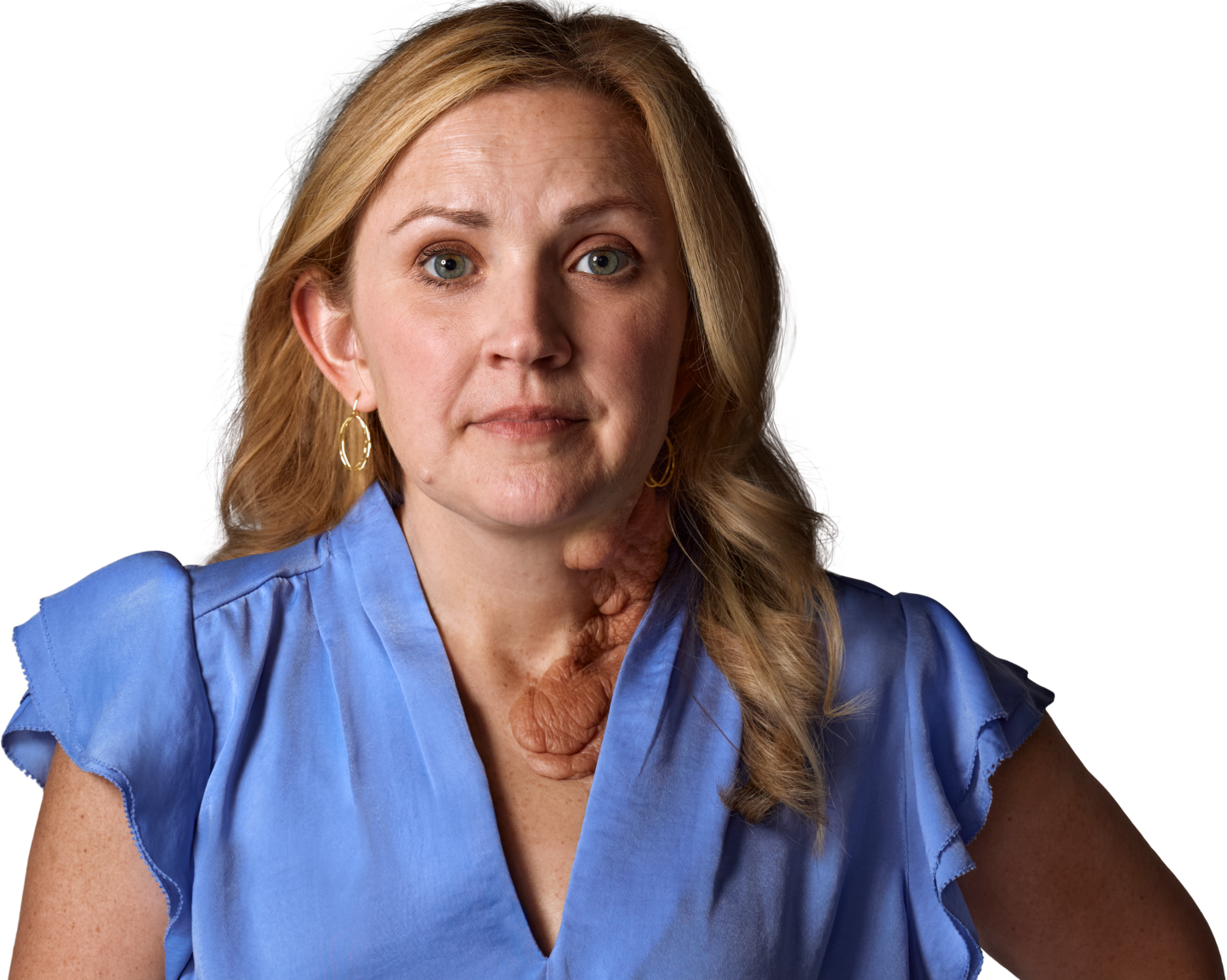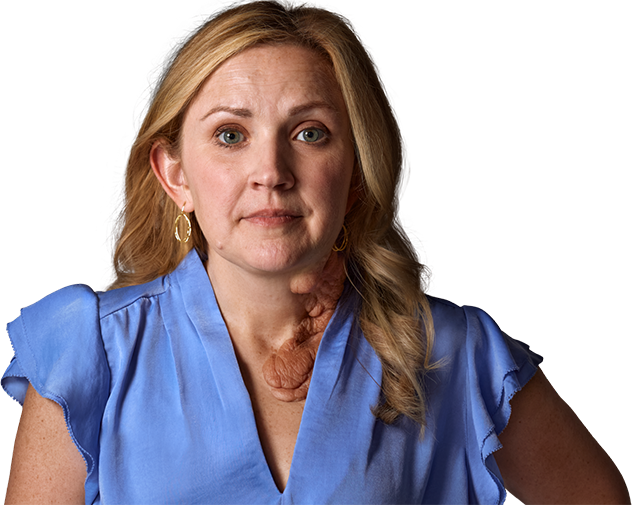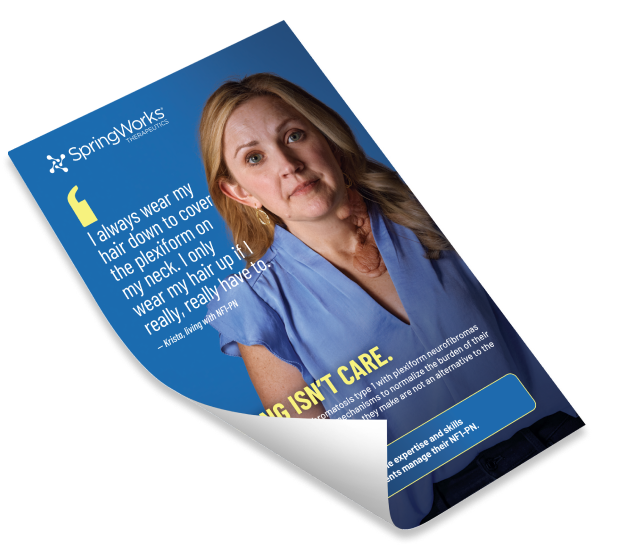This site is intended for US healthcare professionals



type 1 with plexiform neurofibromas (NF1-PN)
Coping isn’t care.
All images and quotes are from real people living with NF1-PN, but every patient’s experience is different.
You have the expertise to help patients manage their NF1-PN rather than just live with it. And we have the resources to help you do that.
About NF1-PN
- Neurofibromatosis type 1 (NF1) is an incurable genetic condition affecting ~1 in 2500 newborns worldwide that is caused by loss-of-function variants in the NF1 tumor-suppressor gene1-4
- People with NF1 have a shorter life expectancy; the median age of death for the US population is 74 years vs 59 years for those living with NF15,*
- Nonmalignant peripheral nerve sheath tumors called plexiform neurofibromas (PNs) are a common clinical manifestation of NF11
- PNs are highly invasive and often cause debilitating morbidities, including pain, changes in appearance, compression of internal organs, impaired physical function, and reduced quality of life (QoL)7,8
- Malignant transformation may occur; malignant peripheral nerve sheath tumors (MPNSTs) occur in up to 16% of patients with NF19,10
- MPNSTs are associated with a 5-year overall survival rate of 35% to 50%9,11
- There are 30,000 to 50,000 people in the US living with NF1-PN, and the majority of them are adults1,6,7,12,13
- See why NF1-PN can be particularly challenging for young adults
Meet Krista
She was diagnosed with NF1-PN at 6 months old. Hear her speak about how she has dealt with the condition.
My name is Krista. I’m 39 years old. I live in San Antonio, Texas.
I was diagnosed with NF1-PN when I was 6 months old.
My parents noticed that I had some distinguishing markings all over my body.
I had the café au lait spots all over my body. I had freckling in my groin and in my armpits, and I had the large plexiform on the left side of my neck.
I didn’t always understand why I had to be at the doctor so much. And I really just wanted to be like the other kids my age. And I think I was navigating this unique time in my life where I looked very different.
I had this large, you know, birthmark, and I had even some, like, hair growing on the side of my face from the plexiform neurofibroma.
As I was transitioning into, like, middle school and high school, I really was just trying to fit in.
I got to college and nobody cared anymore. Nobody was making fun of me, and so I kind of at that point just was, like, I can live with this. You know, I’ll be okay.
My outlook with living with NF is that I’ve always tried to have the mindset of focusing on what I can control and just trying to live life to the fullest.
NF1-PN: A quick guide
Based on an analysis of multiple-cause mortality files compiled from US death certificates by the National Center for Health Statistics from 1983 through 1997.5
- Ejerskov C, Farholt S, Nielsen FSK, et al. Clinical characteristics and management of children and adults with neurofibromatosis type 1 and plexiform neurofibromas in Denmark: a nationwide study. Oncol Ther. 2023;11(1):97-110.
- Lee T-SJ, Chopra M, Kim RH, Parkin PC, Barnett-Tapia C. Incidence and prevalence of neurofibromatosis type 1 and 2: a systematic review and meta-analysis. Orphanet J Rare Dis. 2023;18(1):292.
- Tamura R. Current understanding of neurofibromatosis type 1, 2, and schwannomatosis. Int J Mol Sci. 2021;22(11):5850.
- Yap Y-S, McPherson JR, Ong C-K, et al. The NF1 gene revisited – from bench to bedside. Oncotarget. 2014;5(5):5873-5892.
- Rasmussen SA, Yang Q, Friedman JM. Mortality in neurofibromatosis 1: an analysis using U.S. death certificates. Am J Hum Genet. 2001;68(5):1110-1118.
- Prada CE, Rangwala FA, Martin LJ, et al. Pediatric plexiform neurofibromas: impact on morbidity and mortality in neurofibromatosis type 1. J Pediatr. 2012;160(3):461-467.
- Miller DT, Freedenberg D, Schorry E, Ullrich NJ, Viskochil D, Korf BR; Council on Genetics; American College of Medical Genetics and Genomics. Health supervision for children with neurofibromatosis type 1. Pediatrics. 2019;143(5):e20190660.
- Darrigo LG Jr, Ferraz VEF, Cormedi MCV, et al. Epidemiological profile and clinical characteristics of 491 Brazilian patients with neurofibromatosis type 1. Brain Behav. 2022;12(6):e2599.
- Higham CS, Dombi E, Rogiers A, et al. The characteristics of 76 atypical neurofibromas as precursors to neurofibromatosis 1 associated malignant peripheral nerve sheath tumors. Neuro Oncol. 2018;20(6):818-825.
- Miettinen MM, Antonescu CR, Fletcher CDM, et al. Histopathologic evaluation of atypical neurofibromatous tumors and their transformation into malignant peripheral nerve sheath tumor in patients with neurofibromatosis 1—a consensus overview. Hum Pathol. 2017;67:1-10.
- Zehou O, Fabre E, Zelek L, et al. Chemotherapy for the treatment of malignant peripheral nerve sheath tumors in neurofibromatosis 1: a 10-year institutional review. Orphanet J Rare Dis. 2013;8:127.
- Kallionpää RA, Uusitalo E, Leppävirta J, Pöyhönen M, Peltonen S, Peltonen J. Prevalence of neurofibromatosis type 1 in the Finnish population. Genet Med. 2018;20(9):1082-1086.
- U.S. population estimated at 332,403,650 on Jan. 1, 2022. U.S. Department of Commerce. January 6, 2022. Accessed April 16, 2024. https://www.commerce.gov/news/blog/2022/01/us-population-estimated-332403650-jan-1-2022
